Proofs involving Measurements
Review of Addition Postulates
Many results in geometry depend on lengths of segments or measures of angles. Sometimes the segment addition or angle addition postulates play an important role, so we will state them once again:
Segment Addition Postulate
If P is between A and B, then AP + BP = AB, and conversely.
![]()
Angle Addition Postulate
If ![]() is interior to
is interior to ![]() then
then ![]() , and conversely.
, and conversely.


Angle Inscribed in a Semicircle
Theorem: An angle inscribed in a semicircle is a right angle.
That is, if ![]() and
and ![]() are endpoints of a diameter of a circle with center
are endpoints of a diameter of a circle with center ![]() , and
, and ![]() is a point on the circle, then
is a point on the circle, then ![]() is a right angle.
is a right angle.

Proof:
Draw line ![]() . This is a radius of the circle, as are
. This is a radius of the circle, as are ![]() and
and ![]() , so
, so ![]() . Label the following angle measures:
. Label the following angle measures: ![]()
![]()
![]()
![]()
![]() and
and ![]() :
:
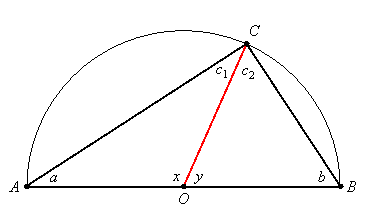
By the isosceles triangle theorem (applied to triangles AOC and BOC), c1 = a and c2 = b. The sum of the angles in any triangle is 180o, so a + c1 + x = 180o and b + c2 + y = 180o. Substituting c1 for a and c2 for b, this gives: 2c1 + x = 180o and 2c2 + y = 180o. If we add these two equations, we have: 2c1 + 2c2 + x + y = 360o. But x + y = 180o since ![]() and
and ![]() are a linear pair. Substituting 180o for x + y gives us 2c1 + 2c2 + 180o = 360o. Subtracting 180o from both sides and dividing by 2 gives: c1 + c2 = 90o. But
are a linear pair. Substituting 180o for x + y gives us 2c1 + 2c2 + 180o = 360o. Subtracting 180o from both sides and dividing by 2 gives: c1 + c2 = 90o. But ![]() , so
, so ![]() is a right angle.
is a right angle.

Perpendicular Bisector of a Chord
A cord of a circle is a segment whose endpoints are on the circle:
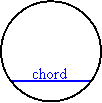
Theorem:
The perpendicular bisector of a chord of a circle passes through the center of the circle.
Proof:
Let the center of the circle be labeled as ![]() , the endpoints of the chord as
, the endpoints of the chord as ![]() and
and ![]() ,
, ![]() the midpoint of
the midpoint of ![]() , and
, and ![]() the point where
the point where ![]() intersects the circle. Then all we have to prove is that
intersects the circle. Then all we have to prove is that ![]() .
.
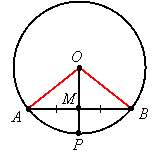
![]() since each is a radius of the circle. Since
since each is a radius of the circle. Since ![]() (
(![]() is the midpoint of
is the midpoint of ![]() ) and
) and ![]() ,
, ![]() by SSS. Because they are corresponding parts of these congruent triangles,
by SSS. Because they are corresponding parts of these congruent triangles, ![]() , so their measures are equal. But these angles are a linear pair, so their measures add to 180o:
, so their measures are equal. But these angles are a linear pair, so their measures add to 180o: ![]() . Substituting
. Substituting ![]() for
for ![]() , we have
, we have ![]() , so
, so ![]() . Therefore
. Therefore ![]() , which makes
, which makes ![]() the perpendicular bisector of
the perpendicular bisector of ![]() .
.

Overlapping Triangles
When triangles overlap, you have to imagine them separately. The following problems illustrate this idea.
Problem 1:
Given: ![]() and
and ![]() are right angles,
are right angles, ![]() , and
, and ![]()
Prove: ![]() is isosceles
is isosceles

Proof:
The overlapping triangles are ![]() and
and ![]() . We will first show they are congruent.
. We will first show they are congruent.
Concentrating on ![]() , since
, since ![]() is between
is between ![]() and
and ![]() ,
, ![]() .
.

Likewise for ![]() ,
, ![]()

Since ![]() , which says
, which says ![]() , we can substitute
, we can substitute ![]() for
for ![]() in
in ![]() to get
to get ![]() . Now we have two equations with the same left sides:
. Now we have two equations with the same left sides:
![]() and
and ![]()
Therefore the right sides are equal: ![]() , so
, so ![]() . We also know
. We also know ![]() and
and ![]() and
and ![]() are right angles, so it follows that
are right angles, so it follows that ![]() by HL. So
by HL. So ![]() because these are corresponding parts of the congruent triangles. They are also angles of
because these are corresponding parts of the congruent triangles. They are also angles of ![]() , so by the isosceles triangle theorem, this is an isosceles triangle with
, so by the isosceles triangle theorem, this is an isosceles triangle with ![]() .
.
Problem 2:
Given: ![]() , and
, and ![]()
Prove: ![]()
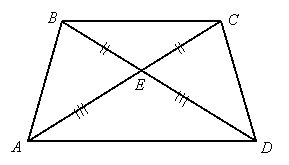
Proof:
We have overlapping triangles ![]() and
and ![]() :
:
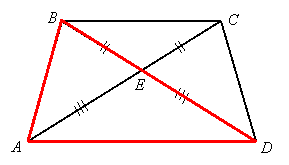
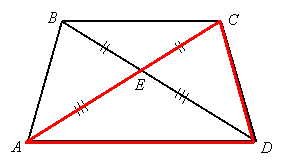
By segment addition, ![]() and
and ![]() . Since
. Since ![]() and
and ![]() , we can substitute lengths to conclude that
, we can substitute lengths to conclude that ![]() , or
, or ![]() . Now
. Now ![]() is isosceles, so by the isosceles triangle theorem,
is isosceles, so by the isosceles triangle theorem, ![]() . We also have a common side,
. We also have a common side, ![]() . Therefore
. Therefore ![]() by SSS, so
by SSS, so ![]() since they are corresponding parts of the congruent triangles.
since they are corresponding parts of the congruent triangles.